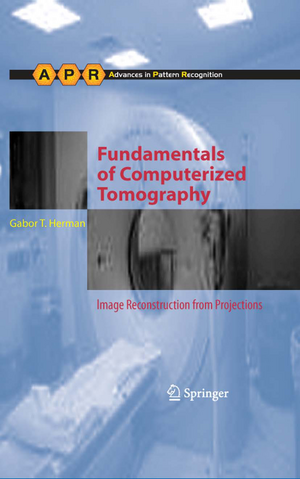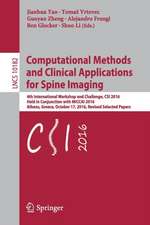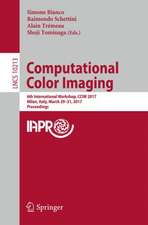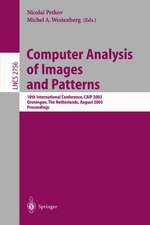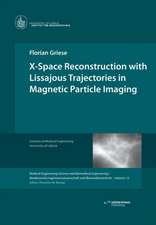Fundamentals of Computerized Tomography: Image Reconstruction from Projections: Advances in Computer Vision and Pattern Recognition
Autor Gabor T. Hermanen Limba Engleză Hardback – 24 sep 2009
| Toate formatele și edițiile | Preț | Express |
|---|---|---|
| Paperback (1) | 760.14 lei 6-8 săpt. | |
| SPRINGER LONDON – 14 mar 2012 | 760.14 lei 6-8 săpt. | |
| Hardback (1) | 1166.52 lei 6-8 săpt. | |
| SPRINGER LONDON – 24 sep 2009 | 1166.52 lei 6-8 săpt. |
Din seria Advances in Computer Vision and Pattern Recognition
- 20%
 Preț: 998.36 lei
Preț: 998.36 lei - 20%
 Preț: 409.80 lei
Preț: 409.80 lei - 20%
 Preț: 654.70 lei
Preț: 654.70 lei - 20%
 Preț: 775.30 lei
Preț: 775.30 lei - 20%
 Preț: 867.15 lei
Preț: 867.15 lei - 20%
 Preț: 241.87 lei
Preț: 241.87 lei - 20%
 Preț: 659.83 lei
Preț: 659.83 lei - 20%
 Preț: 1084.17 lei
Preț: 1084.17 lei - 20%
 Preț: 328.60 lei
Preț: 328.60 lei - 20%
 Preț: 650.08 lei
Preț: 650.08 lei - 20%
 Preț: 644.66 lei
Preț: 644.66 lei - 20%
 Preț: 652.54 lei
Preț: 652.54 lei - 20%
 Preț: 646.80 lei
Preț: 646.80 lei - 20%
 Preț: 993.60 lei
Preț: 993.60 lei - 20%
 Preț: 1174.92 lei
Preț: 1174.92 lei - 20%
 Preț: 646.80 lei
Preț: 646.80 lei - 20%
 Preț: 672.36 lei
Preț: 672.36 lei - 20%
 Preț: 920.33 lei
Preț: 920.33 lei - 20%
 Preț: 825.78 lei
Preț: 825.78 lei - 20%
 Preț: 666.58 lei
Preț: 666.58 lei - 18%
 Preț: 953.65 lei
Preț: 953.65 lei - 20%
 Preț: 999.35 lei
Preț: 999.35 lei - 20%
 Preț: 655.02 lei
Preț: 655.02 lei - 20%
 Preț: 595.16 lei
Preț: 595.16 lei - 20%
 Preț: 647.61 lei
Preț: 647.61 lei - 20%
 Preț: 658.33 lei
Preț: 658.33 lei - 20%
 Preț: 1649.61 lei
Preț: 1649.61 lei - 20%
 Preț: 991.46 lei
Preț: 991.46 lei - 20%
 Preț: 994.08 lei
Preț: 994.08 lei - 20%
 Preț: 1062.57 lei
Preț: 1062.57 lei - 20%
 Preț: 985.16 lei
Preț: 985.16 lei - 20%
 Preț: 640.35 lei
Preț: 640.35 lei - 20%
 Preț: 656.03 lei
Preț: 656.03 lei - 18%
 Preț: 950.52 lei
Preț: 950.52 lei - 20%
 Preț: 652.41 lei
Preț: 652.41 lei - 20%
 Preț: 644.81 lei
Preț: 644.81 lei - 20%
 Preț: 996.40 lei
Preț: 996.40 lei
Preț: 1166.52 lei
Preț vechi: 1458.15 lei
-20% Nou
Puncte Express: 1750
Preț estimativ în valută:
223.24€ • 232.21$ • 184.30£
223.24€ • 232.21$ • 184.30£
Carte tipărită la comandă
Livrare economică 14-28 aprilie
Preluare comenzi: 021 569.72.76
Specificații
ISBN-13: 9781852336172
ISBN-10: 185233617X
Pagini: 312
Ilustrații: XII, 300 p. 98 illus.
Dimensiuni: 155 x 235 x 20 mm
Greutate: 0.66 kg
Ediția:2nd ed. 2010
Editura: SPRINGER LONDON
Colecția Springer
Seria Advances in Computer Vision and Pattern Recognition
Locul publicării:London, United Kingdom
ISBN-10: 185233617X
Pagini: 312
Ilustrații: XII, 300 p. 98 illus.
Dimensiuni: 155 x 235 x 20 mm
Greutate: 0.66 kg
Ediția:2nd ed. 2010
Editura: SPRINGER LONDON
Colecția Springer
Seria Advances in Computer Vision and Pattern Recognition
Locul publicării:London, United Kingdom
Public țintă
Professional/practitionerCuprins
An Overview of the Process of CT.- Physical Problems Associated with Data Collection in CT.- Computer Simulation of Data Collection in CT.- Data Collection and Reconstruction of the Head Phantom.- Basic Concepts of Reconstruction Algorithms.- Backprojection.- Filtered Backprojection for Parallel Beams.- Other Transform Methods for Parallel Beams.- Filtered Backprojection for Divergent Beams.- Algebraic Reconstruction Techniques.- Quadratic Optimization Methods.- Truly Three-Dimensional Reconstruction.- Three-Dimesional Display of Organs.- Mathematical Background.
Recenzii
From the reviews of the first edition.
"... the author is a giant in the field. One expects an exciting book and one is not disappointed."
S. Webb, Physics in Medicine and Biology, v. 26. p. 721, 1981.
"... the book is an excellent introduction to the subject and is well written, thoughtfully organized, and a pleasure to read."
M.W. Vannier, The Journal of Nuclear Medicine, v. 23, p. 369, 1982.
"On the one hand the book is well suited for a course on computerized tomography at the graduate level, on the other hand I found it a well balanced review on the subject for somebody outside the field."
W.N Brouw, Space Science Reviews, v.32. p. 467, 1982.
"This book will be valuable to the engineer, the physicist, the mathematician, and the physician (with a sufficient mathematical background) interested in the field of CT."
M.M. Ter-Pogossian, Medical Physics, v. 11, p. 90, 1984.
"... the author is a giant in the field. One expects an exciting book and one is not disappointed."
S. Webb, Physics in Medicine and Biology, v. 26. p. 721, 1981.
"... the book is an excellent introduction to the subject and is well written, thoughtfully organized, and a pleasure to read."
M.W. Vannier, The Journal of Nuclear Medicine, v. 23, p. 369, 1982.
"On the one hand the book is well suited for a course on computerized tomography at the graduate level, on the other hand I found it a well balanced review on the subject for somebody outside the field."
W.N Brouw, Space Science Reviews, v.32. p. 467, 1982.
"This book will be valuable to the engineer, the physicist, the mathematician, and the physician (with a sufficient mathematical background) interested in the field of CT."
M.M. Ter-Pogossian, Medical Physics, v. 11, p. 90, 1984.
Textul de pe ultima copertă
Computerized tomography, the process of obtaining the density distribution within a human body from multiple x-ray projections, has revolutionized diagnostic radiology over the past three decades. Fundamentally the same computational process has been used for reconstruction from projections in many other fields of science, engineering and medicine; for example, for the reconstruction of biological macromolecules from electron micrographs.
This thoroughly revised and fully updated text/reference presents the computational and mathematical procedures underlying data collection, image reconstruction, and image display in computerized tomography. Focused on the needs of the practitioner, with emphasis on reconstruction methods, the book carefully discusses points of implementation and application.
Following the successful formula of the widely cited first edition, the book investigates the field of computerized tomography in detail, summarizing the diverse applications of the technique. Further chapters concentrate on reconstruction algorithms, followed by a treatment of the 3D display of the results and a final chapter with proofs of the fundamental mathematical theorems.
Some entirely new topics are introduced; these include the fast calculation of a ray sum for a digitized picture, the task-oriented comparison of reconstruction algorithm performance, blob basis functions and the linogram method for image reconstruction.
Topics and features:
*Describes how projection data are obtained and the resulting reconstructions are used in science and medicine, focusing on x-ray data but also covering other fields such as electron microscopy, nuclear medicine, ultrasound, materials science and nondestructive testing
*Presents a comparative evaluation of reconstruction methods, their accuracy under ideal and realistic circumstances, computational costs, task-oriented performance, and general applicability
*Provides a useful general syllabus for introductory courses
*Investigates reconstruction algorithms, including filtered backprojection, Fourier and linogram reconstruction methods, algebraic reconstruction techniques, and quadratic optimization
*Explores basis functions, functions to be optimized, norms, generalized inverses, least squares solutions, and maximum entropy solutions, as well as most likely estimates
*Discusses the design and application of a large programming system (SNARK09) for image reconstruction, as well as computerized methods for 3D surface detection and display
*Concludes each chapter with helpful Notes and References sections
This easy-to-read text/reference is an excellent guide for practitioners from a range of disciplines across science, engineering, and medicine. Based on three decades of the author’s teaching, it can also serve as a textbook for an introductory graduate course on image reconstruction.
This thoroughly revised and fully updated text/reference presents the computational and mathematical procedures underlying data collection, image reconstruction, and image display in computerized tomography. Focused on the needs of the practitioner, with emphasis on reconstruction methods, the book carefully discusses points of implementation and application.
Following the successful formula of the widely cited first edition, the book investigates the field of computerized tomography in detail, summarizing the diverse applications of the technique. Further chapters concentrate on reconstruction algorithms, followed by a treatment of the 3D display of the results and a final chapter with proofs of the fundamental mathematical theorems.
Some entirely new topics are introduced; these include the fast calculation of a ray sum for a digitized picture, the task-oriented comparison of reconstruction algorithm performance, blob basis functions and the linogram method for image reconstruction.
Topics and features:
*Describes how projection data are obtained and the resulting reconstructions are used in science and medicine, focusing on x-ray data but also covering other fields such as electron microscopy, nuclear medicine, ultrasound, materials science and nondestructive testing
*Presents a comparative evaluation of reconstruction methods, their accuracy under ideal and realistic circumstances, computational costs, task-oriented performance, and general applicability
*Provides a useful general syllabus for introductory courses
*Investigates reconstruction algorithms, including filtered backprojection, Fourier and linogram reconstruction methods, algebraic reconstruction techniques, and quadratic optimization
*Explores basis functions, functions to be optimized, norms, generalized inverses, least squares solutions, and maximum entropy solutions, as well as most likely estimates
*Discusses the design and application of a large programming system (SNARK09) for image reconstruction, as well as computerized methods for 3D surface detection and display
*Concludes each chapter with helpful Notes and References sections
This easy-to-read text/reference is an excellent guide for practitioners from a range of disciplines across science, engineering, and medicine. Based on three decades of the author’s teaching, it can also serve as a textbook for an introductory graduate course on image reconstruction.
